Off script
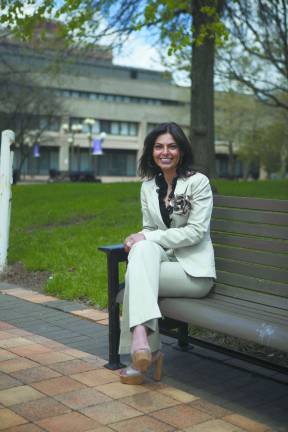



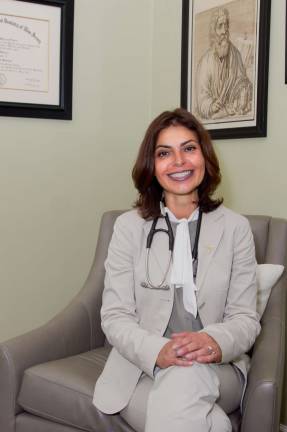
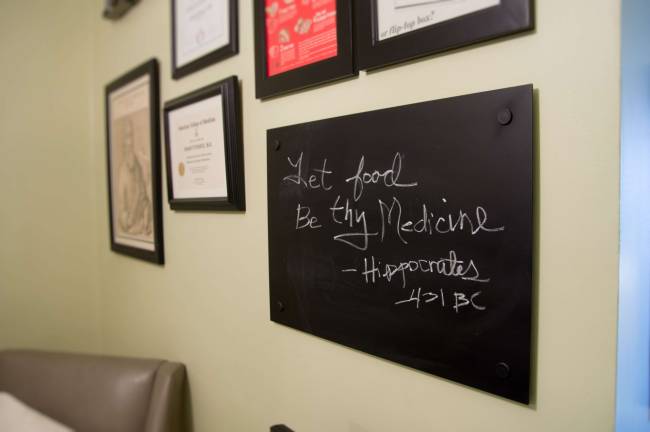
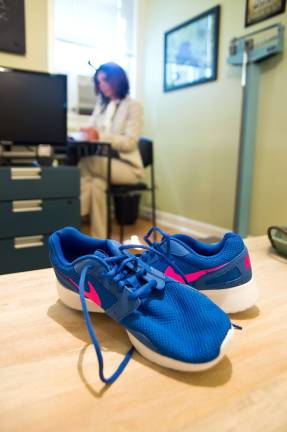
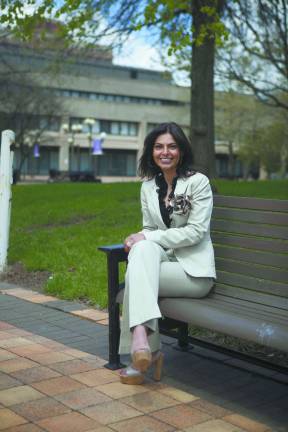
Struck by multiple sclerosis, a desperate young doctor discovers the healing power of food
By Emily Kahoud
Photos by Tom Ciriello
Go off your drugs, and you can expect to be in a wheelchair by 40.
It was a dire prognosis that Dr. Saray Stancic, who had gone from promising medical resident to multiple sclerosis patient overnight, heard from her neurologist.
“Nursing home, diaper, wheelchair, 40. That was the picture that everyone was painting for me,” said Stancic.
The drugs, though, were producing side effects – shaking chills, flu-like illness and unrelenting insomnia – that Stancic found unbearable, necessitating more medication. She soon found herself taking almost a dozen different prescriptions, and still the disease marched onward.
Stancic was in her early thirties when, in the middle of an overnight shift at the E.R., she turned from chief resident to patient. Her legs went numb, and an emergency MRI revealed plaques in her brain and spinal cord: multiple sclerosis. Unlike chronic diseases such as type 2 diabetes and cardiovascular disease, which are commonly driven by a lifetime of health transgressions, MS has the particularly insidious habit of attacking young women in their prime.
MS is a frightening diagnosis, and Stancic immediately understood the grave implications. The degenerative autoimmune inflammatory disease of the central nervous system causes the myelin sheath—the rubber insulation to our body’s delicate nerves, which are the electrical wiring that powers all of our muscles, glands, and organs—to deteriorate as our body’s immune system turns its powerful arsenal against us.
“I was on the drugs and still having exacerbations every couple of months,” said Stancic. “I could see myself losing a little bit every day.”
Stancic wrote an account of her transformation for the website Forks Over Knives:
“I was no longer Dr. Stancic, making early morning rounds on her patients. I was now the newly admitted MS patient, lying in a bed as a flock of medical students and doctors took turns assessing my deteriorating neurological status. … I had become a drug-dependent, sick young woman struggling to accept her fate. MS had swiftly swept away my dreams and aspirations, and left behind a shadow of my former self.”
It is often in times of intense suffering that, in our desperation for relief, we become open to inspirations that our healthier, happier selves would be too busy or too skeptical to notice.
“I was at a point where I was open to anything,” said Stancic. “In many ways I was desperate.”
Hope arrived via the unlikely avenue of a “throwaway” medical journal containing articles rife with scientific inaccuracies. Though the scientist in her recognized the study’s blunders, the concept of the cover story intrigued Stancic: blueberries and the improvement of MS symptoms.
Stancic began to scour the medical literature for rigorous, peer-reviewed studies that related nutrition to the treatment of chronic diseases. Piece by piece, she gathered evidence that a plant-based diet may be a powerful weapon in halting the progression of chronic illness, and possibly even reversing damage already done.
Once she knew where to look, Stancic discovered a plethora of studies demonstrating that phytonutrients—plant-based nutrients that act as chemical keys to the receptor locks of our bodies’ approximately 37 trillion cells—may reduce inflammation and provide the antioxidant salve to soothe the free radical wear and tear of the body’s metabolic processes.
As Stancic recalls her former “typically American diet” of Diet Coke, Chinese food, and Subway sandwiches, even over the phone, one can practically see her grimace.
“I had a lot of cleaning up to do,” she said. Gradually, she began to introduce “simpler, cleaner foods,” including the “power foods”: fruit, vegetables, nuts and seeds, and whole grains. And she cut out the highly processed foods. She shed pounds “without even thinking about it.”
She also introduced physical activity, despite the unique barriers MS presented – like the cane or crutch she often used to get from car to office.
She started out with a stationary bike, and initially she would do very little. “Every time my heart rate and temperature went up, I would become symptomatic.” She would lose feeling in her legs and would feel an awful “rush of tingling” upon stopping. It would take her 15 to 20 minutes to get back to baseline.
“I had faith that this was going to be my path to improvement. I did it every day, no matter what, even if I didn’t feel good,” she says.
Gradually, she was able to “build it up,” and after a year, then two, then three, the fruits of her labor grew increasingly evident. The change did not happen overnight, and she is certain to convey this to her patients from the start. But it was nothing short of a metamorphosis: from disability and drug-dependency, Stancic was able to increase her tolerance to exercise from five minutes for a month, to five and a half minutes for another month, and kept gradually building on this progress until she could do an hour.
Jogging evolved to running, and in 2010, 15 years after her diagnosis – and after getting off all her meds – she did what had been unthinkable back when she needed a crutch to cross the parking lot: she ran a marathon. This year, she has also pledged to walk 2,015 miles in 2015, or an average of 5.5 miles a day. Her practice’s website displays a tally, updated frequently: “As of July 20th I have completed 10982 miles,” it said on July 24 – putting her just about on target.
Getting healthy requires work, Stancic warns her patients, and with progressive autoimmune diseases such as MS, there is no cure. However, by feeding one’s body the essential nutrients that may dramatically reduce inflammation and bolster our immune system’s healthy responses, the inexorable progression of chronic diseases may be averted; and possibly, as in Stancic’s case, the disease may regress, a result we cannot achieve with pharmaceutical intervention.
Lifestyle interventions, you say?
This may sound like another cliché to those who are thinking, “I know, I know, diet and exercise. I’m already doing that.” But even those of us who count ourselves healthy eaters may be a little more sanguine than we should.
There’s quite a gap between how Americans view their eating habits versus the reality of what we put in our mouths. Nine out of ten of us believe we are eating “somewhat,” “very,” or “extremely” healthy, a 2011 Consumer Reports poll of more than 1,200 American adults found. Yet only 13.1% of us meet fruit intake recommendations, and only 8.9% eat enough veggies, says a 2013 Centers for Disease Control and Prevention survey. At least a quarter of American adults eats fast food every day, according to Eric Schlosser, author of Fast Food Nation: The Dark Side of the All-American Meal.
Put 100 random Americans in a room, and 66 would be overweight or obese. Twenty-five would eat fast food daily. Only nine would be eating enough vegetables. And 90 of us would say we ate well? What gives?
Could it be our profoundly American dedication to the protein myth? “I suspect most Americans equate protein with health, and conclude more must be better,” a belief we now know to be “ill-conceived,” Stancic said.
“People who follow a Western diet—loaded with meat and dairy products—consume about twice the amount of necessary protein, as well as excessive amounts of saturated fat and cholesterol,” according to the Physicians Committee for Responsible Medicine.
“The protein myth began years ago when protein [equaled] health. Remember TV shows in the 50s like Leave it to Beaver always depicted Mom pulling the roast from the stove to assure she was nurturing her family? I also have ads of physicians promoting cigarettes,” Stancic said. “When we know better, we do better.”
Rather than getting caught up in terminology like high protein, low carb or low fat, paleo or gluten-free, Stancic focuses on “simplifying a seemingly complex field with too many conflicting opinions… It is simply about increasing whole plant based foods on our plates and leaving less room for the other stuff’,” she said, “about eating the whole food in its simple, unadulterated form.”
Topping the list of “other stuff”: processed faux foods layered with sugar, salt and fat, the so-called “hyperpalatable foods” epitomized by the Snickers bar.
Compounding our collective eating issue is our blind faith in pharmaceuticals. Drugs have become a modern day enabler, giving patients license to stick with bad habits by masking the symptoms of disease. “McLipitor Syndrome,” Stancic calls this behavior: people taking statins think they are free to eat Big Macs since the drug has them covered.
“We are a society that largely relies on drugs to correct our health issues,” she said. “Little credence is given to lifestyle as a therapeutic approach to prevent and manage disease, despite the fact that we know lifestyle is a more effective therapeutic approach than a drug in many instances.” To highlight that point, Stancic shares a study comparing pre-diabetic patient outcomes, in which lifestyle intervention proved almost twice as effective as the drug metformin in reducing incidence of diabetes in high-risk people.
“Once we get on the [pharmaceutical] bandwagon, it gets hard to come off,” Stancic said. She knows, firsthand.
Her own pharmaceutical bandwagon began with Betaseron, the injectable MS disease modifying drug that has side effects like flu-like illness, which would wake her with shaking chills and fever in the middle of the night. She was then given Ambien to help her get back to sleep. Yet the Ambien prevented her from being able to wake in the morning, so she was prescribed Provigil to wake up. “Then I felt depressed and anxious so I was given Prozac,” she said. “You see how this can snowball into a multi-drug dependent state.”
“The most tragic part of this,” Stancic said, “is that despite all the drugs the quality of life for many remains deeply compromised.”
In Dr. Stancic’s current practice, Stancic Health and Wellness in Ridgewood, NJ, she is no longer confined to standard 15 minute appointment slots. Instead, she dedicates two hours to each patient upon initial consultation, an intimate session one could usually only afford with an M.D. if on top of a surgical table, under the knife.
Stancic, trained as an infectious disease physician and former Chief of Infectious Diseases at the Hudson Valley VA, makes no bones about the fact that “there is a time and a place for drugs” like antibiotics. But none of these drugs come without a cost, as we have found with antibiotic resistance. Her practice targets three fundamentals that, with or without drugs, are imperative: “How we eat, how we move, and managing our stress.”
A hesitation to rely solely on drugs as the first line of therapy is rare among white coats. This may be due in part to the fact that at last count, only a quarter of U.S. medical schools require the recommended 25 hours of nutritional coursework. More than 75% of U.S. health care dollars go to treat chronic diseases linked to diet, according to the CDC, yet nutrition is still considered a soft subject – the “home economics” of medical school, taking a back seat to fields like biochemistry and pharmacology.
To those who justify bad habits with excuses, Stancic acknowledges that, sure, “we are all going to die.” But this is not only about death; “it’s about increasing the odds that we’re going to age gracefully.”
The idea is “to avoid the three to four years of chronic suffering before death that we see so often here in the U.S.,” she said. “It’s to not pass away in a nursing home with multiple chronic illnesses, demented.”
“It’s like investing into your 401k,” she tells younger patients. You need to think: “I’m saving money now for retirement 30 years from now.”
Do this so that you don’t get there and think, “God, I wish I had.”